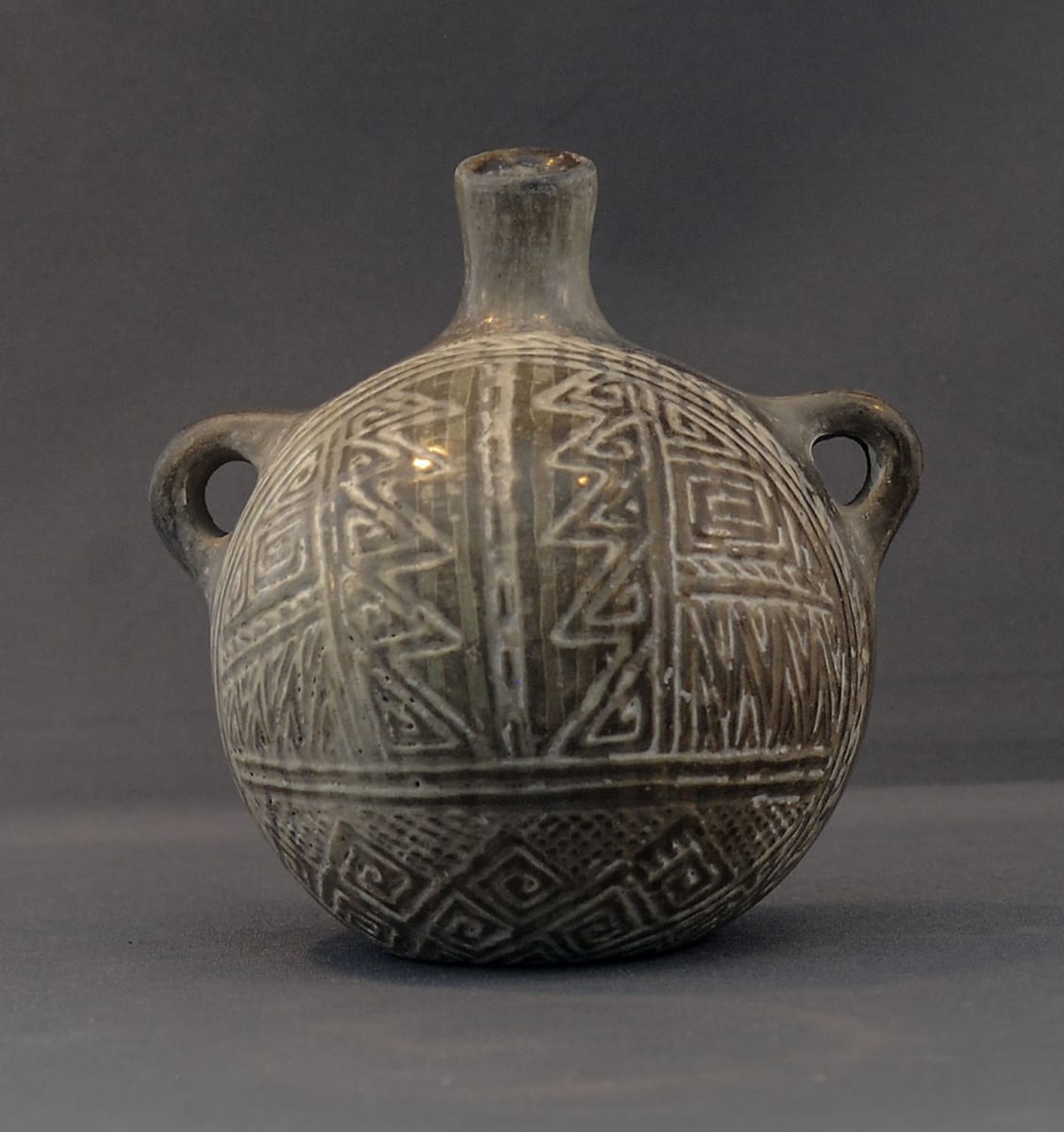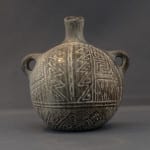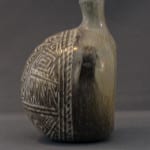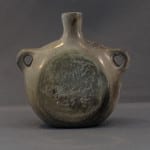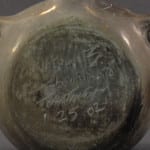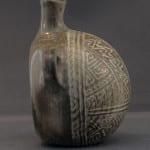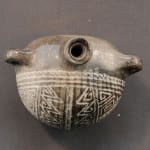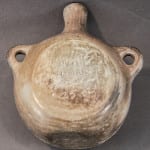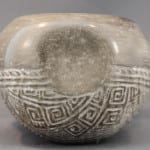This small canteen is Nathan Begaye sui generis, being his unique self. I am not aware of any other Pueblo ceramicist who uses decorating techniques even remotely similar to those used here, though Ed Wade links Begaye’s incising to prehistoric pottery of the eastern woodlands and Midwestern prairies (Wade and Cooke 2012:225).
The canteen is made entirely of a white clay (kaolin?) that may be commercially bought. The handles are fixed about two-thirds up the sides of the vessel and the spout tilts forward, characteristics of canteens by Nampeyo, though the spout here is constricted by a narrowed waist. Both Nampeyo and Begaye had enormously fertile and inventive minds. It is impossible to know if Begaye learned this style from Nampeyo’s examples or if it is simply that different artists sometimes arrive at the same solutions.
Incised on the flat back of the canteen are “Nathan B, Hopi-Navajo,” a line of clouds with falling rain, and the date of production: “1-25-02.”
The design elements are standard Southwest motifs: triangular or square crooks (perhaps representing moving water), areas of cross hatch and chevrons (perhaps representing cultivated fields), with these areas bordered by straight lines that segment the design. The layout is somewhat symmetrical with a central line running about two-thirds down from the top, flanked by vertical areas of triangular crooks, which leaves a series of stepped triangles in the center. These triangles form a “cloud ladder” wand (omausaka paho) carried by katchinas. “It is thought that this ladder carries a message to the clouds to help bring clouds and rain for the crops” (Branson 1992:231). This same image is interpreted by Alexander Stephen as the pottery symbol for “woman” (Patterson 1994:253). Potters on Third Mesa told Wyckoff (1985:105) that these triangles represent the corn plant. The three interpretations may be, in fact, complementary. Rain, fertile women, and corn are all images of nurturing and emergent life. Flanking this central motif at the top are more images of square and triangular crooks, again perhaps representing flowing water. Below are areas of chevrons, perhaps representing cultivated fields. The bottom third of the convex area is decorated with a crook plus three curved rows of more square crooks, interspersed by cross-hatched areas. As with many cultural expressions from the Southwest, this canteen may be a prayer or a thanksgiving for rain, fecundity, and life. The fact that such sentiment appears on a canteen that itself has the shape of a pregnant woman would seem most appropriate.
The whole design is bounded by two circular lines, followed by a larger corded impression that marks the transition between the carved area and the smoothly polished finish from in front of the handles to the rear. These framing lines partially obliterated a fourth line of crooks at the base of the jar.
Nathan, though not inducted into the religious societies of either his Hopi or Navajo parents, had a deep visceral connection to the traditions and symbols of his peoples. His use of traditional Southwest symbols here seems natural. Whether he consciously intended the specific interpretations offered above, applied a meaningful pattern of symbols unconsciously, or simply decorated by whim cannot be known. It seems that artists often have some integrated intentionality of design and later art historians elaborate meanings considerably beyond this original intention. In the case of canteen 2013-09, the viewer can see whatever she or he wishes.
The canteen fits smoothly into the hand, has a strong tactile attraction, and begs to be caressed and felt, like a string of smooth prayer beads. Although the canteen is new, Nathan has achieved a surface patina that both reflects the light and deepens the visual impression of the surface.
Commenting of a much larger but similarly incised pot by Nathan, Ed Wade writes that the color contrast between the darker raised surfaces and the lighter incised lines “was achieved through the application prior to firing of an organic solution that resisted surface blackening from the reduction atmosphere that colors the rest of the vessel. Eventually this solution burns off –gone, like a too-brief life, leaving a lighter surface where it had once been” (Wade and Cooke 2012:225).
Canteen 2013-09 was fired the same day (1-25-02) as another pot by Nathan added to the collection about ten years later (2022-15). Interestingly both pots are dark and deeply-carved, though the pot added more recently has a more elaborate design than even canteen 2013-09.

